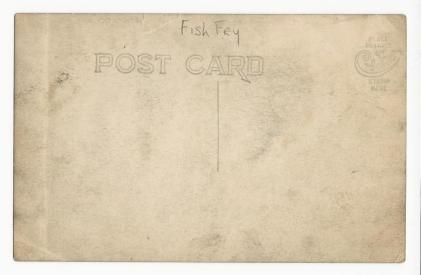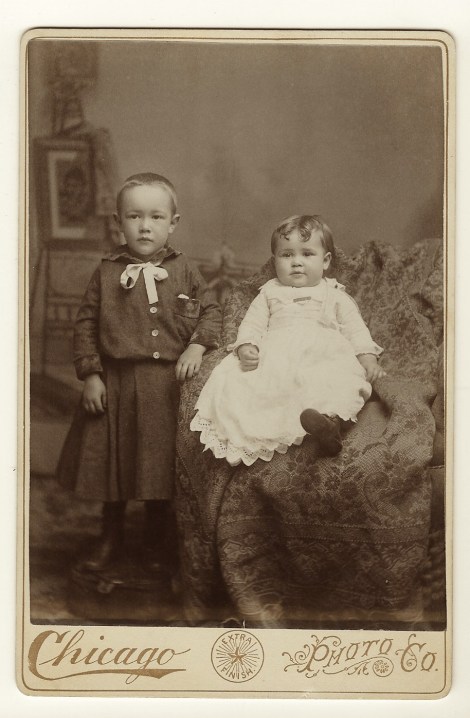This item is a vintage postcard featuring the very attractive theater actress Sybil Arundale (1879-1965). Her stage roles included a number of Shakespeare plays. Her sister Grace was also an actress. The postcard was produced by Philco Publishing Company in London, England. It is number 3005 in a series. The photographer was Alexander Bassano (1829-1913) who was a leading royal and high society photographer located in London. SOLD
PORTRAIT OF A CUTE BABY IN PARIS, FRANCE (VINTAGE PHOTOGRAPH)
This post cabinet card era photograph features a very cute baby photographed by the Angelidis Studio in Paris, France. The photographer did an excellent job of posing this incredibly adorable child. The photograph measure 4″ x 5 1/2″.
THE WORLDS SWEETEST BABY STANDS ON A CHAIR IN PORTLAND, OREGON
This cabinet card portrait features a thirteen month old baby who an inscriber on the reverse of the photograph describes as the “Sweetest in the world”. The child’s name is written as “Dagmar Albright Games. The child in this photograph does in fact look quite sweet and is flashing a wonderful expression. The kid was born to model. She is standing on a velvet chair and is wearing some sort of a flimsy gown. The photograph was taken at the Busby & Company Studio in Portland, Oregon. Research reveals that according to the the 1910 US Census, Dagmar A. Games was living in Portland (Ward 4), Oregon.. She was 21 years old (born in 1889), unemployed and living in a boarding house. The 1920 census indicates that she was married to Frederick Swanberg who was employed as a manager of an ice company. Dagmar was unemployed and she and her husband were living in San Francisco. Dagmar’s mother, Anna Games, was living with the couple. The 1930 US Census discloses that Dagmar and her mother still lived in San Francisco but Frederick no longer resided with them. SOLD
YOUNG EUROPEAN MAN WEARING A UNIFORM (CARTE DE VISITE)
This Carte de Visite features a uniformed young man posing at the Cruf Studio which had galleries in Freiburg, Mannheim, and Basel. The first two cities are in Germany and Basel is located in Switzerlan. An inscription on the reverse of the photograph indicates that the subject is H. Wolff. Mr Wolff is wearing a uniform representing an unknown group. Perhaps he is a student or maybe he works for the railroad. His group affiliation remains unknown for the time being. Looking at the reverse of the photograph also reveals that the Cruf Studio won a number of medals at photographic competitions. The latest medal listed was recieved in 1888 which means that this image dates back to 1888 or later. (SOLD)
BEAUTIFUL COUPLE MAKING A BIRTHDAY TOAST IN LUCKENWALDE, GERMANY (VINTAGE PHOTO)
TWO MEN MANNING THE DEEP FRYER AND DOING SOME SERIOUS COOKING (VINTAGE REAL PHOTO POSTCARD)
THE WEDDING PARTY: TWO COUPLES IN MINNEAPOLIS, MINNESOTA
This cabinet card features a bride and groom and a couple from their wedding party. The brides gown is a bit unusual. One can find many dark colored wedding dresses but this one seems to be made from an unusual material. Perhaps someone can leave a comment that identifies the fabric. The bride is wearing a very long veil and is also wearing many flowers from her waist to the top of her dress. This photograph was taken by the Oswald Brother’s Studio in Minneapolis, Minnesota. The studio was located at 1227 and 1229 Washington Avenue North from at least 1887 through 1895. Prior to that address, the Oswalds operated out of a gallery at 116 Thirteenth Avenue North. A later location was 1221 Washington Avenue North. Charles Otto Oswald (1859-1940) and Emil C. Oswald (1864-1944) were Swiss born.
PORTRAIT OF TWO SIBLINGS IN CHICAGO, ILLINOIS
An adorable little boy poses alongside his little brother/sister at the Chicago Photo Company Studio. The children are looking at the photographer with apprehension. The unidentified children are nicely dressed. The Chicago Photo Company, not surprisingly, was located in Chicago, Illinois. (SOLD)
IMAGE AND STORY: YOUNG SOLDIER COMES HOME FROM WORLD WAR I (VINTAGE REAL PHOTO POSTCARD)
On November 11th, 1918, World War I came to an end. It was a joyous time and soldiers and sailors from all the fighting nations were able to return home to their loved ones. This real photo postcard provides a visual image of that time in history. We see two ships speeding home on a a rough ocean. The postcard shows an American soldier who is portrayed as being on one of these ships. Note the American flag in the background as well as the flags on each ship. This was truly a patriotic time. On the reverse of the postcard is a most interesting message. On 12/13/18, about a month after the war’s end, Richard M. Daebelliehn (1889-1964) wrote a message to his wife. I will decipher it the best that I can as it is not totally legible. “Dear Wife, I will wire you just as soon as I hit USA and will have you meet me. You can be expecting a telegram from me”. He signed his name and followed it with an alphabet soup of letters, “HQ (headquarters) M.O.R.S. (?) A. E. F. (American Expeditionary Force) France. It also appears that the word “Cook” appears before his name. Daebelliehn sent this postcard to his wife who was living in Davenport, Iowa. Research reveals that his wife’s name was Grace Luttsia Anderson. The 1920 US census reports that the couple had two children, Dorothea (age 9), and Robert (age 7). The census, as well as many city directories, indicate that Richard was a butcher (meat cutter) for many years. In fact, he owned his own business. Knowing that Richard was a butcher before the war likely explains why he was a cook in the military. Richard and his family lived in Rock Island, Illinois at the time of the census. I wish I could say that after Richard was reunited with his family that they lived happily together for many years. However, Grace died in September of 1921 in Springfield, Illinois. Richard remarried (Margaret Daebelliehn) sometime before 1930. This postcard was produced by Furia, a French postcard company. The postcard certainly is a relic of history with an image on one side and a story on the other side.

















